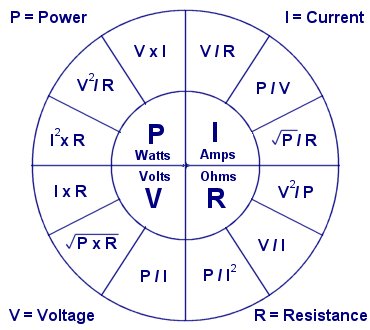
Sparkies are as much mathematicians as they are electricians, writes David Herres
Ohm’s Law is the single most used formula for electricians. In its most fundamental form E = I x R, where ‘E’ is the electromagnetic force (volts), ‘R’ is resistance (ohms) and ‘I’ is intensity (amps).
This is the one to remember. From this single formula, simple algebraic transpositions allow you to solve for each of the terms so that electrical calculations can be readily performed. You don’t have to even bother with this simple task if you have the Ohm’s Law Wheel before you (see Figure 1).
As you can see, the inner circle of the Ohm’s Law Wheel contains four terms: watts, volts, amps and ohms. Each of these equates with any of the three expressions in the corresponding quarter of the outer circle. For example, in the lower left quarter, amps is seen to equal watts divided by volts.
Electricians frequently use this equation to size circuits – that is, to ascertain wire size based on ampacity. The procedure is to consult the nameplate or documentation associated with a particular appliance or piece of equipment, such as a space heater. The size of the load is often given in watts, but you need to know the amps to size the circuit. The Ohm’s Law Wheel tells you to divide watts by volts to find amps. Use the nominal system volts or rated volts on the nameplate, as opposed to measured volts, which may vary a small amount depending on utility policy, position on the power line and local loading.
Another common calculation performed by electricians, especially in troubleshooting faulty equipment, is also found in the lower left quarter of the Ohm’s Law Wheel. You won’t often be solving for E (volts) because that is predetermined by the application. You will need to solve for I (amps) or R (ohms).
Frequently, an older piece of motorised equipment will undergo progressive insulation breakdown due to moisture and/or repeated overheating. The current (as measured with a clamp-on ohmmeter) will read abnormally high or the resistance (as measured with a multimeter set for the ohms function) will read abnormally low. The equipment will be seen to overheat and the motor, especially under load) will not attain its rated speed, or fail to start altogether.
These and other simple calculations, based on the Ohm’s Law Wheel, will facilitate sizing circuits for new installations and gaining insight into the reasons for equipment malfunction.
Of course all of this depends upon understanding the exact meanings of amps, ohms and volts.
1A is defined as the quantity of electrons that flows past any given point on a circuit. Needless to say, the number is very large: 628 followed by 28 zeros. Volts and ohms are derivable from this value. Specifically, one volt is the amount of electromagnetic force that will drive 1A through a resistance of 1Ω. Moreover, 1Ω is the amount of resistance that will limit current flowing through it to one amp.
In all cases, Ohm’s Law works to find one of the three quantities we have discussed when the other two are known. The situation is a little more complicated at higher AC frequencies, and sometimes adjustments have to be made. However, at the 50Hz and 60Hz (cycles per second) in use worldwide, the deviation from DC values is not pronounced for most applications.
We have to consider another term: impedance (Z). Like resistance, impedance is measured in ohms. It is the sum of resistance, capacitive reactance and inductive reactance. These latter terms refer to the opposition to the flow of current offered by a capacitor and the opposition to the flow of current by an inductor, either a plain conductor or a conductor that is wound in the form of coil.
We often use the word ‘impedance’ when talking about the opposition to the flow of current within a source of power – generator, battery or the secondary winding of a transformer. Internal impedance acts like a resister in series with the power source. A low impedance power source undergoes less voltage drop when connected to a relatively heavy load. There is maximum power transfer when the impedances of source and load are equal, or matched. If the source impedance is high, the voltage drops to a lower level. When the load impedance is high, the current is limited in accordance with Ohm’s Law. When source and load impedances are the same, there is maximum current flow.
Besides Ohm’s Law, there are numerous other theorems and equations applicable to the world of electronics. Thevenin’s Theorem, Norton’s Theorem, Superposition Theorem, Reciprocity Theorem, Compensation Theorem, Millman’s Theorem and others address the situation where a circuit has multiple power sources, combination series and parallel loads, and so on. These complex circuits all adhere to Ohm’s Law, but the analysis is difficult and time-consuming. The above theorems simplify the calculations by offering several generalizations that apply. Such calculations, however, are not required of working electricians. These theorems are used by power engineers and electronics technicians who deal with advanced circuitry.
One set of formulations that is of great use to electricians, especially in troubleshooting faulty equipment, is known as Kirchhoff’s Laws. Many technicians intuitively understand the principles even if they have never heard of Kirchhoff or know of his laws.
In 1847, G.R. Kirchhoff discovered a simple formulation that extends Ohm’s Law so that it applies to the voltage and current in a series circuit loop.
Simply put, at any instant the currents flowing into any component in a circuit is equal to the current flowing out of that component. The current throughout a series circuit is the same everywhere.
If you visualise current flow in a series circuit as a uniform stream that leaves the hot side of the source and returns via a grounded neutral conductor or via another hot leg, you will be well on the road to understanding the circuit and locating any faults.
These are some of the basic concepts used by electricians to trace circuitry and troubleshoot faulty equipment. A most useful item in the electrician’s toolbox is a graphic version of Ohm’s Law Wheel, which displays the interactions of these fundamental properties of the universe.




